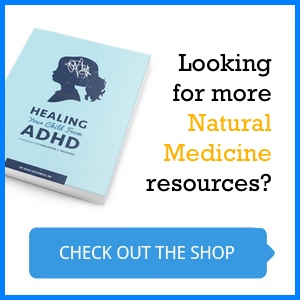
Is Your Child Getting Enough Vitamins and Minerals? A Guide to Testing for Nutritional Deficiencies (Part 3 – Iron)
Could your child have an iron deficiency?
Iron deficiency is very common in kids, especially in infants and teen girls. Read on for the signs of iron deficiency, how to test for it, and what you can do to prevent it.
This article is the third in a series all about nutritional deficiencies, which are fairly common, even in developed countries like the United States. Nutritional deficiencies occur when a person isn’t consuming or absorbing enough of one or more necessary nutrients. Nutritional deficiencies can refer to lack of macronutrients like a protein deficiency, or insufficient blood levels of specific vitamins and minerals. Depending on the severity of the deficiency, it can have a profound and long-standing effect on health.
In this series I discuss some of the most common vitamin and mineral deficiencies seen in children and adolescents. I also explain what lab tests can be used to comprehensively assess your child’s nutritional status.
In case you missed the previous installments of this series, here is Part 1: Vitamin D and Part 2: B Vitamins.
Common Causes of Nutritional Deficiencies
First, let me start with a brief explanation about why vitamin and mineral deficiencies can happen. If you want more information about this topic, my first article talks about these causes in much more detail.
In general, nutrient deficiencies occur because of:
- Lack of adequate nutrition or not consuming enough of a specific vitamin or mineral
- An increased need for certain nutrients
- Health conditions that affect the body’s ability to absorb nutrients
- Consuming high amounts of a food (or medication) that inhibits the absorption of another vitamin or mineral
Part 3: Iron Deficiency in Kids
Importance of Iron
Iron is an essential mineral that is important to many biological processes. Iron is a component of many proteins and enzymes in the body and it’s involved in energy production, oxygen transport, red blood cell synthesis, immune function, DNA replication and repair, and antioxidant and detoxification pathways.1 In short, without iron our bodies wouldn’t be able to function.
Signs and Symptoms of Iron Deficiency in Children
Iron deficiency can cause a number of different health problems. Here are some of the most common symptoms you may notice in a person who has an iron deficiency:
Anemia
Iron-deficiency anemia occurs when there isn’t enough iron to support normal red blood cell production. Red blood cells play a vital role in health by carrying oxygen throughout the body. This is essential for normal energy production and many other metabolic functions.
Signs of anemia can include tiredness, dizziness, shortness of breath, anxiety, fast or irregular heartbeats, and pale skin. In people with darker skin tones, pallor is most noticeable in the inner eyelid, palms, and nail beds. In females that menstruate anemia can also cause very heavy periods.
Fatigue
Although anemia is common when someone’s iron stores get low enough, it’s possible to be deficient in iron without being anemic. However even if the deficiency isn’t severe enough to cause anemia, iron deficiency on its own often causes fatigue. Fatigue in children can present as irritability, lack of focus, sleeping more than usual, lack of motivation, decreased physical stamina, or lack of interest in play, sports, or other physical activities.
Pica
Pica is the persistent behavior of eating non-food items like ice, dirt, or paint chips. Although this is common in babies who literally put everything in their mouths, this is not a normal behavior in older children or adults. In some cases pica can be a sign of iron deficiency. Anyone with pica disorder should be seen by a health care provider because the behavior can lead to toxicity, infection, or intestinal blockage from the ingested substances.
Breath Holding Spells
Breath-holding spells may occur when a child is crying because they are upset, scared, or hurt. During the spells the child turns pale or bluish and loses consciousness. The episodes are involuntary, meaning the child has no control over when, where, or whether they happen. Breath-holding spells may look similar to a seizure, although no seizure activity is happening in the brain. These episodes can be extremely frightening to witness, however they are generally harmless. Breath-holding spells are fairly common, effecting about 5% of children. They are most common in young children, often starting around 6-18 months of age and usually resolving by the time the child enters elementary school.2
Although anemia doesn’t cause breath-holding spells, if a child already experiences breath-holding spells, anemia can make them worse. In this case, treating their anemia with iron can reduce the frequency of the episodes.3
Poor School Performance
Children who are iron deficient often don’t do as well in school as their peers. Iron deficiency can impair cognitive function and motor skills, and even lead to long-term behavioral changes.4 A recent study of adolescent girls suggests that iron-deficiency, even when not accompanied by anemia, is associated with decreased attention span, IQ, and mathematics scores, as well as impairments in memory, concentration, and verbal retention.5
How common is Iron Deficiency in Children?
Iron deficiency is one of the most common nutritional deficiencies in the United States. The Centers for Disease Control (CDC) estimates that about 7% of all children are iron deficient based on blood testing, but the frequency varies in children of different ages. Somewhere between 6.6-15.2% of toddlers aged 1-3 years are iron deficient and 0.9-4.4% in this age group are frankly anemic.6 In teen girls who have started menstruating, the percentage effected by iron deficiency is estimated to be about 10%.7
Because so many children are affected by iron deficiency and anemia, the World Health Organization (WHO) and the American Academy of Pediatrics recommend universal screening for all children at 1 year of age. Screening is usually a part of a 12 month well-child check, but if you have concerns your child may be iron deficient screening blood tests can be ordered at any time.
Risk Factors for Iron Deficiency
Iron Deficiency in Infants
Infants have a high risk for iron deficiency, especially in the first 12 months of life. Babies normally build up their iron stores during the third trimester of pregnancy assuming that mom had sufficient amounts of iron to pass along. Iron deficiency in pregnancy has been linked to pre-term labor and low-birth weight newborns. Delayed cord clamping at birth can significantly impact an infant’s iron stores. If baby did receive enough iron in utero, their stores should last them about 4-6 months. This is important because breast milk is a relatively poor source of iron and infant digestive tracts aren’t able to absorb much iron until about 6 months of age. Iron deficiency between 7 and 12 months of age is common because of the continued need for iron despite dwindling stores from birth. 8
Increased Need for Iron in Athletes
Children, teens, and adults who engage in regular strenuous exercise likely need a little more iron to meet their body’s needs. Intense training can boost red blood cell counts and the number of small blood vessels in the body, increasing the physiological demand for iron. Endurance exercise can also cause blood loss through the digestive tract and urinary system. Additionally, there is a phenomenon called “Foot Strike Hemolysis” that can affect runners. When feet repeatedly pound pavement or other hard surfaces red blood cells can become damaged. And you guessed it; in order to replace these damaged red blood cells the body needs plenty of iron!9
Vegetarian or Vegan Diets
Unfortunately, iron found in plant sources is less efficiently absorbed then the iron that comes from animal sources. In fact, the recommended dietary allowance (RDA) of iron for vegetarians is 1.8 times higher than the RDA for non-vegetarians.10 Even so, it is definitely possible to get enough iron as a vegetarian, especially when eating a varied whole-foods based diet.
Digestion/Malabsorption Issues
Chronic diseases that affect the digestive tract can impair absorption of vitamins and minerals like iron. Iron deficiency is very common in people who have celiac disease and inflammatory bowel diseases, like ulcerative colitis or crohn’s.
Blood Loss and Heavy Periods in Teens
During times of heavy blood loss the body often can’t restore adequate levels of iron fast enough, and this can lead to anemia. Unfortunately, anemia can also cause heavier bleeding, setting up a vicious cycle for many women. This may be due to dysfunction in platelets that is induced when hematocrit levels become low.11
Testing Options to Assess Iron Levels
Serum Iron Testing
Although you might expect a simple iron blood test would be the best test for evaluating iron levels in the body, it’s actually usually only helpful when used along with other tests. This is because the levels of iron in your blood can fluctuate dramatically depending on what you recently ate or if you’re taking an iron supplement. Serum iron really only reflects a momentary snapshot of someone’s iron status rather than their tissue’s stores.
Ferritin
Ferritin is an iron storage protein. In healthy children and adults it can be a helpful indicator of iron status in the body and it’s usually one of the first tests I run on my patients when evaluating for iron deficiency. However, in people with certain health conditions it may be less accurate. This is because ferritin is also an acute-phase reactant. Acute-phase reactants are proteins involved in inflammatory and infectious processes. If ferritin levels are out of range your doctor will likely order follow up tests to determine the reason for the abnormality.
Complete Blood Count
The complete blood count (often referred to as a CBC) is a lab test that looks closely at the cellular and protein components that make up the blood. A CBC provides important information about white blood cells, red blood cells, and platelets. It’s commonly ordered to evaluate for infections, anemia, clotting disorders, and other diseases of the blood. A health care provider will also be able to look at a CBC for clues about someone’s iron status.
In severe iron deficiency a person will become anemic, meaning they will have lower than normal amounts of red blood cells (RBC). Anemia is also characterized by decreased hematocrit and hemoglobin levels. Hemoglobin is an iron-containing protein in RBC that helps transport oxygen. Hematocrit refers to the density of RBC in the blood. A low hematocrit means there are less RBC than normal, whereas a high hematocrit means the blood is very dense with RBC. Because only a small amount of blood is needed for the test, hemoglobin and hematocrit levels are the most common first tests ordered to diagnose iron deficiency in infants and toddlers.
Additionally, when someone is iron deficient their RBC often look small and pale. This would show up in a CBC as a low Mean Corpuscular Volume (MCV) and low Mean Corpuscular Hemoglobin Concentration (MCHC).
Should I give my child an iron supplement?
Unless prescribed by a doctor, it usually isn’t safe to give children more than the Recommended Daily Allowance (RDA) of iron. In high doses iron can be quite toxic. Excess amounts of iron promote free radicals that cause cellular damage throughout the body. Acute iron toxicity is the most common cause of poisoning deaths in children under six years old.12
The best way to prevent iron deficiency is a healthy, whole foods diet and a high quality multivitamin. Most children’s multivitamins contain a small amount of iron that is well within a safe level for kids.
RDA of Iron for Children and Adolescents13
Males (mg/day) Females (mg/day)
| Infants | 0-6 months | 0.27 | 0.27 |
| Infants | 7-12 months | 11 | 11 |
| Children | 1-3 years | 7 | 7 |
| Children | 4-8 years | 10 | 10 |
| Children | 9-13 years | 8 | 8 |
| Adolescents | 14-18 years | 11 | 15 |
Dietary Sources of Iron
Animal products including beef, lamb, pork, chicken, turkey, fish, seafood, and eggs are good sources of easily absorbable heme iron. Some vegetarian foods also have iron, although usually in smaller amounts and in a less absorbable nonheme form. Good vegetarian sources of iron include beans, lentils, tofu, dried apricots and figs, raisins, pumpkin seeds, sesame seeds, hemp seeds, flax seeds, leafy green vegetables, broccoli, tomato paste, potatoes, white mushrooms, and black strap molasses.14
For more sources of iron-rich foods see our other article: Iron-rich foods for kids and infants
It’s also important to know that certain nutrients can affect iron absorption. Vitamin C can significantly increase absorption of both heme and nonheme iron, while calcium can decrease absorption. If your child is taking both a calcium and iron supplement it’s best to space them out at least 2 hours apart.
Thanks for reading and keep an eye out for the 4th and final installment of this series on nutritional deficiencies, featuring the minerals Magnesium and Zinc!
References:
1, 8, 12, 13. Iron. (2018, April 18). Retrieved September 13, 2018, from https://lpi.oregonstate.edu/mic/minerals/iron#function
2. Roddy, S., MD. Breath-Holding Spells. Retrieved October 17, 2018, from http://www.childneurologyfoundation.org/disorders/breath-holding-spells/
3. Mocan, H., Yildiran, A., Orhan, F., & Erduran, E. (1999). Breath holding spells in 91 children and response to treatment with iron. Archives of Disease in Childhood, 81(3), 261-262. doi:10.1136/adc.81.3.261
4. Jáuregui-Lobera, I. (2014). Iron deficiency and cognitive functions. Neuropsychiatric Disease and Treatment, 2087. doi:10.2147/ndt.s72491
5. More, S., Shivkumar, V. B., Gangane, N., & Shende, S. (2013). Effects of Iron Deficiency on Cognitive Function in School Going Adolescent Females in Rural Area of Central India. Anemia, 2013, 1-5. doi:10.1155/2013/819136
6. Baker, R.D., Greer, F.R. Baker, R. D., & Greer, F. R. (2010). Diagnosis and Prevention of Iron Deficiency and Iron-Deficiency Anemia in Infants and Young Children (0-3 Years of Age). Pediatrics, 126(5), 1040-1050. doi:10.1542/peds.2010-2576 2010;126(5):1040-1050.
7. Pfeiffer, C. M., Sternberg, M. R., Schleicher, R. L., Haynes, B. M., Rybak, M. E., & Pirkle, J. L. (2013). The CDCs Second National Report on Biochemical Indicators of Diet and Nutrition in the U.S. Population Is a Valuable Tool for Researchers and Policy Makers. The Journal of Nutrition, 143(6). doi:10.3945/jn.112.172858
9. Fact Sheet: Iron Depletion in Athletes. (2009, February). Retrieved October 22, 2018 from https://www.sportsdietitians.com.au/wp-content/…/04/Iron_depletion_in_athletes.pdf
10. Institute of Medicine (US) Panel on Micronutrients. Dietary Reference Intakes for Vitamin A, Vitamin K, Arsenic, Boron, Chromium, Copper, Iodine, Iron, Manganese, Molybdenum, Nickel, Silicon, Vanadium, and Zinc. Washington (DC): National Academies Press (US); 2001. Available from: https://www.ncbi.nlm.nih.gov/books/NBK222310/ doi: 10.17226/10026
11. Valeri, C. R., Cassidy, G., Pivacek, L. E., Ragno, G., Lieberthal, W., Crowley, J. P., . . . Loscalzo, J. (2001). Anemia-induced increase in the bleeding time: implications for treatment of nonsurgical blood loss. Transfusion, 41(8), 977-983. doi:10.1046/j.1537-2995.2001.41080977.x
14. 21 Vegetarian Foods That Are Loaded With Iron. Retrieved October 17, 2018, from https://www.healthline.com/nutrition/iron-rich-plant-foods#section3




MARIA
August 19, 2021 at 2:29 pmDo you consider the supplementation with tissue salts (a combination including ferrum phos) useful?